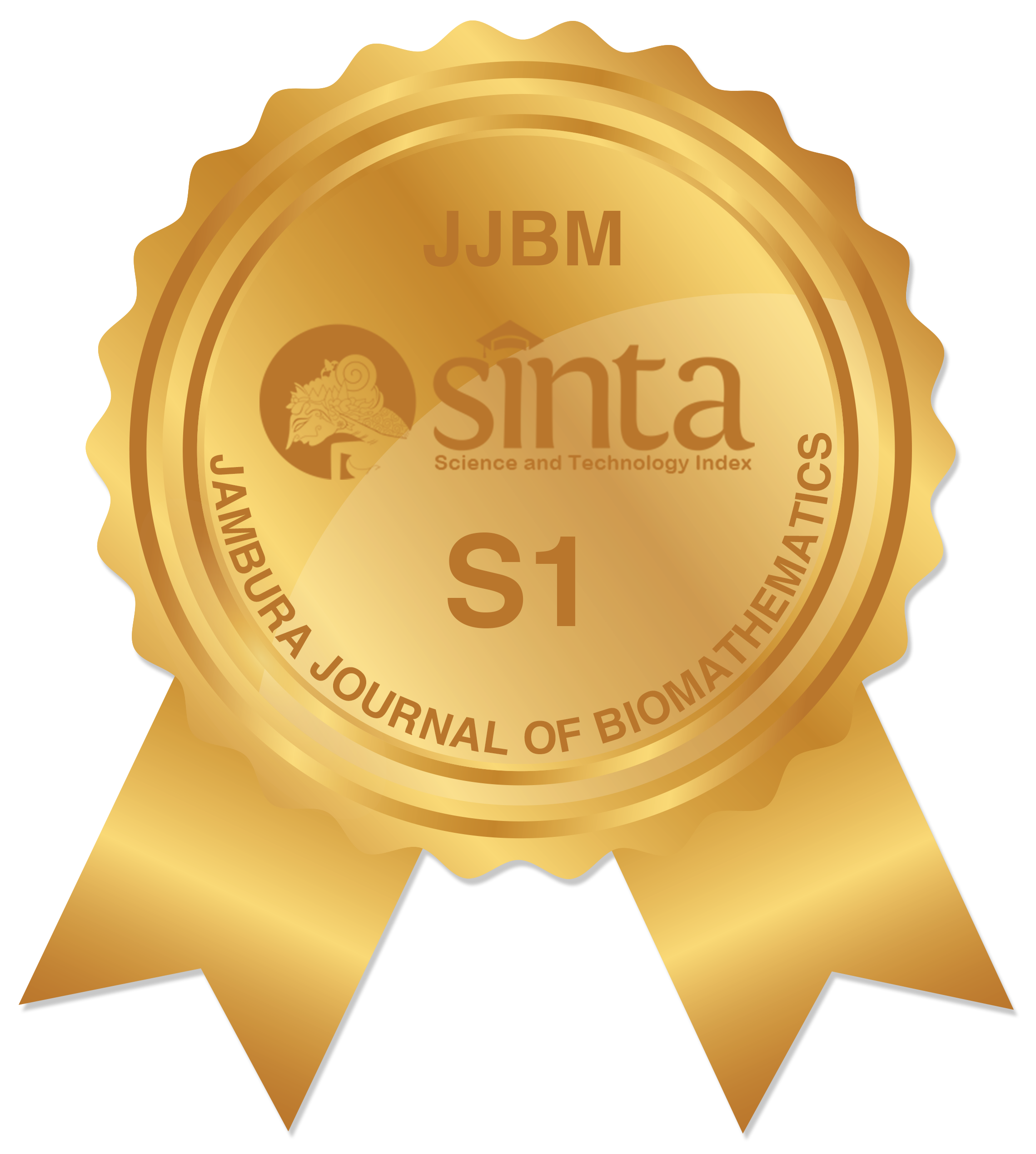Mathematical Model of the Impact of Home-Based Care on Contagious Respiratory Illness Under Optimal Conditions
Abstract
Mathematical models are vital for understanding real-world phenomena without direct experimentation, particularly in epidemics, as they predict and analyze the effectiveness of various mitigation strategies. Given the rapid transmission of infectious respiratory diseases, public health measures aim to curb spread while managing impacts. This study assesses rapid contact tracing and testing, focusing on isolating confirmed cases through home-based care or traditional methods, on coronavirus transmission within a community.A deterministic mathematical model using ordinary differential equations segments the population into seven compartments: susceptible, exposed, asymptomatic, symptomatic, home-based care, hospitalized, and recovered. The basic reproduction number is determined via the next generation matrix. Local stability of the disease-free equilibrium is analyzed using the trace-determinant method, while global stability is confirmed with the Lyapunov-Krasovskii approach. A Python-based numerical simulation on NumPy and PyPlot uses parameters calibrated to previous studies and estimated for this research. Simulations indicate home-based care delays peak infection days and reduces peak population, providing time to bolster healthcare facilities. Optimal control methods, including media awareness, reduce susceptibility and encourage asymptomatic individuals to choose home-based care. Using Pontryagin's Maximum Principle, the study identifies optimal strategies, highlighting that media awareness effectively lowers susceptibility and optimal control directs asymptomatics to home-based care, reducing strain on healthcare facilities. In conclusion, home-based care is effective for managing mild symptomatic and asymptomatic cases, alleviating pressure on healthcare resources and prioritizing severe cases. Combining home-based care with other non-pharmaceutical strategies is recommended for maximum effectiveness.
Keywords
Full Text:
PDFReferences
J. Panovska-Griffiths, "Can mathematical modelling solve the current Covid-19 crisis?," BMC Public Health, vol. 20, no. 1, p. 551, 2020. DOI:10.1186/s12889-020-08671-z
D. K. Gathungu et al., "Modeling the effects of nonpharmaceutical interventions on COVID-19 spread in Kenya," Interdisciplinary Perspectives on Infectious Diseases, vol. 2020, pp. 1-10, 2020. DOI:10.1155/2020/6231461
A. R. Tuite, D. N. Fisman, and A. L. Greer, "Mathematical modelling of COVID-19 transmission and mitigation strategies in the population of Ontario, Canada," Canadian Medical Association Journal, vol. 192, no. 19, pp. E497-E505, 2020. DOI:10.1503/cmaj.200476
L. Mpinganzima et al., "Compartmental mathematical modelling of dynamic transmission of COVID-19 in Rwanda," IJID Regions, vol. 6, pp. 99-107, 2023. DOI:10.1016/j.ijregi.2023.01.003
B. N. Kim et al., "Mathematical model of COVID-19 transmission dynamics in South Korea: the impacts of travel restrictions, social distancing, and early detection," Processes, vol. 8, no. 10, p. 1304, 2020. DOI:10.3390/pr8101304
S. Mwalili et al., "SEIR model for COVID-19 dynamics incorporating the environment and social distancing," BMC Research Notes, vol. 13, no. 1, p. 352, 2020. DOI:10.1186/s13104-020-05192-1
V. Ojiambo et al., "A Human-Pathogen SEIR-P Model for COVID-19 Outbreak under different intervention scenarios in Kenya," MedRxiv, 2020. DOI:10.1101/2020.05.15.20102954
R. K. Titus, L. R. Cheruiyot, and C. P. Kipkurgat, "Mathematical modeling of Covid-19 disease dynamics and analysis of intervention strategies," Mathematical Modelling and Applications, vol. 5, no. 3, p. 176, 2020. DOI:10.11648/j.mma.20200503.16
I. M. Wangari et al., "Mathematical modelling of COVID-19 transmission in Kenya: a model with reinfection transmission mechanism," Computational and Mathematical Methods in Medicine, vol. 2021, pp. 1-18, 2021. DOI:10.1155/2021/5384481
S. Olaniyi et al., "Mathematical Modelling and Optimal Cost-Effective Control of COVID-19 Transmission Dynamics," The European Physical Journal Plus, vol. 135, no. 11, p. 938, 2020. DOI:10.1140/epjp/s13360-020-00954-z
H. M. Wanjala, "Mathematical Modelling of SARS-CoV-2 Incorporating Non-Pharmaceutical Interventions Coupled with Vaccination," Doctoral dissertation, Chuka University, 2023.
C. Connelly, "Epidemiology Through the Lens of Differential Equations," 2023.
R. K. MA, S. Sugiarto, and S. Nurwijaya, "Dynamical System for Tuberculosis Outbreak with Vaccination Treatment and Different Interventions on the Burden of Drug Resistance," Jambura Journal of Biomathematics (JJBM), vol. 5, no. 1, pp. 10-18, 2020.
DOI:10.37905/jjbm.v5i1.21903
R. S. Sihaloho and H. Nasution, "Dynamic analysis of SEIR model for Covid-19 spread in Medan," Jambura Journal of Biomathematics (JJBM), vol. 3, no. 2, pp. 68-72, 2022. DOI:10.34312/jjbm.v3i2.16878
B. Pantha, F. B. Agusto, and I. M. Elmojtaba, "Optimal control applied to a visceral leishmaniasis model," Electronic Journal of Differential Equations, vol. 2020, no. 01-132, p. 80, 2020. DOI:10.58997/ejde.2020.80
Z. H. Shen et al., "Mathematical modeling and optimal control of the COVID-19 dynamics," Results in Physics, vol. 31, p. 105028, 2021. DOI:10.1016/j.rinp.2021.105028
S. Lenhart and J. T. Workman, Optimal control applied to biological models, Chapman and Hall/CRC, 2007.
K. Dehingia et al., "Dynamical behavior of a fractional order model for within-host SARS-CoV-2," Mathematics, vol. 10, no. 13, p. 2344, 2022. DOI:10.3390/math10132344
C. Castillo-Chavez, and B. Song, "Dynamical models of tuberculosis and their applications,". Mathematical Biosciences & Engineering, vol. 1, no. 2, pp. 361-404, 2004. DOI:10.3934/mbe.2004.1.361
B. Buonomo and C. Vargas-De-León. "Stability and bifurcation analysis of a vector-bias model of malaria transmission," Mathematical Biosciences, vol. 242, no. 1, pp.59-67, 2013. DOI:10.1016/j.mbs.2012.12.001
DOI: https://doi.org/10.37905/jjbm.v5i2.27611
Copyright (c) 2024 Henry Milimo Wanjala, Mark Okongo, Jimrise Ochwach

This work is licensed under a Creative Commons Attribution-NonCommercial 4.0 International License.
Jambura Journal of Biomathematics (JJBM) has been indexed by:
EDITORIAL OFFICE OF JAMBURA JOURNAL OF BIOMATHEMATICS |
 | Department of Mathematics, Faculty of Mathematics and Natural Science, Universitas Negeri Gorontalo Jl. Prof. Dr. Ing. B. J. Habibie, Moutong, Tilongkabila, Kabupaten Bone Bolango 96554, Gorontalo, Indonesia |
 | Email: [email protected] |
 | +6281356190818 (WA Only) |
 | Jambura Journal of Biomathematics (JJBM) by Department of Mathematics Universitas Negeri Gorontalo is licensed under a Creative Commons Attribution-NonCommercial 4.0 International License. Powered by Public Knowledge Project OJS. |















